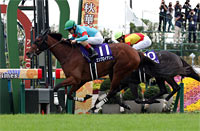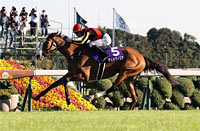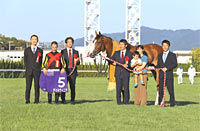Shuka Sho (G1) - Data Analysis
Final stage of the Fillies’ Triple Crown
The Shuka Sho is the third and final leg of the Triple Crown for three-year-old fillies, following the Oka Sho (Japanese 1000 Guineas) and Yushun Himba (Japanese Oaks) in the spring. This year’s Oka Sho was won by Reine Minoru and the Oaks by Soul Stirring. As summer gives way to fall and we approach this contest for the autumn’s champion three-year-old filly, let’s look for some trends in this race based on results over the last 10 years.
Check the finish and time difference in the previous outing
Let’s start by aggregating performances of runners over the last 10 years in terms of their finish in their previous outing. Although those with a final position of “1st” last time out have better success ratios than those finishing “2nd or lower,” the difference between them is not particularly decisive. This suggests that it would be unwise to discount fillies beaten to “2nd or lower” last time out. [Table 1]
[Table 1] Performance by finish last time out (last 10 years)
| Finish last time out |
Performance
[1st-2nd-3rd-4th or lower] |
Win ratio |
Top 2 ratio |
Top 3 ratio |
| 1st |
3-4-3-37 |
6.4% |
14.9% |
21.3% |
| 2nd or lower |
7-6-7-112 |
5.3% |
9.8% |
15.2% |
Focusing next on performances by horses beaten to “2nd or lower” in their previous race in terms of the time difference behind the race winner, those with a time difference of “0.2 seconds or less” have achieved far better success ratios here than those with differences of “0.3 seconds or more.” A defeat in the previous race might not be such a negative factor if the time difference was “0.2 seconds or less.” [Table 2]
[Table 2] Performance of runners finishing 2nd or lower last time out, by time difference behind the winner (last 10 years)
| Time difference |
Performance
[1st-2nd-3rd-4th or lower] |
Win ratio |
Top 2 ratio |
Top 3 ratio |
| 0.2 seconds or less |
5-4-4-22 |
14.3% |
25.7% |
37.1% |
| 0.3-0.5 seconds |
1-0-0-22 |
4.3% |
4.3% |
4.3% |
| 0.6-0.9 seconds |
0-1-0-27 |
0% |
3.6% |
3.6% |
| 1.0 seconds or more |
1-1-3-40 |
2.2% |
4.4% |
11.1% |
Note: Excluding cases when the last race was overseas.
Ascendancy of fillies with strong favoritism in recent turf graded races
If we break down the performances of runners over the last 10 years by their highest favoritism in turf graded races within their last two outings, each of the groups backed as “1st-5th favorite” in that time has achieved a Top 2 ratio in excess of 10%, while those backed as “6th favorite or lower” and those with “No such race entered” within their last two outings have only managed 5% or lower. Of the 10 winners here, nine fall into the “1st-4th favorite” bracket, suggesting that fillies supported by strong favoritism in recent turf graded races should certainly not be overlooked. [Table 3]
[Table 3] Performance by highest favoritism in turf graded races within the last 2 outings (last 10 years)
| Highest favoritism |
Performance
[1st-2nd-3rd-4th or lower] |
Win ratio |
Top 2 ratio |
Top 3 ratio |
| 1st favorite |
6-0-3-12 |
28.6% |
28.6% |
42.9% |
| 2nd favorite |
0-3-1-12 |
0% |
18.8% |
25.0% |
| 3rd favorite |
1-1-0-12 |
7.1% |
14.3% |
14.3% |
| 4th favorite |
2-1-0-6 |
22.2% |
33.3% |
33.3% |
| 5th favorite |
0-2-0-11 |
0% |
15.4% |
15.4% |
| 6th-9th favorite |
0-2-1-37 |
0% |
5.0% |
7.5% |
| 10th favorite or lower |
0-0-4-20 |
0% |
0% |
16.7% |
| No such race entered |
1-1-1-39 |
2.4% |
4.8% |
7.1% |
Note: Excluding overseas races
Success in turf graded races since May is also important
Over the last 10 years, nine of the 10 winners and 18 of the 20 Top 2 finishers had achieved a highest finish of 5th or higher in turf graded races since May of that year. In terms of success ratios, too, runners with highest finishes of “1st,” “2nd” and “5th” in that time have Top 2 ratios of 25% or higher. A record of vying for the higher positions in turf graded races since May should perhaps deserve special attention. [Table 4]
[Table 4] Performance by highest finish in turf graded races since May that year (last 10 years)
| Highest finish |
Performance
[1st-2nd-3rd-4th or lower] |
Win ratio |
Top 2 ratio |
Top 3 ratio |
| 1st |
6-3-4-10 |
26.1% |
39.1% |
56.5% |
| 2nd |
2-2-1-10 |
13.3% |
26.7% |
33.3% |
| 3rd |
0-2-1-13 |
0% |
12.5% |
18.8% |
| 4th |
1-0-0-12 |
7.7% |
7.7% |
7.7% |
| 5th |
0-2-0-6 |
0% |
25.0% |
25.0% |
| 6th-9th |
0-0-3-34 |
0% |
0% |
8.1% |
| 10th or lower |
0-0-0-25 |
0% |
0% |
0% |
| No such race entered |
1-1-1-39 |
2.4% |
4.8% |
7.1% |
Check for Top 2 finishes within the last four outings
Comparing the performances of runners over the last 10 years in terms of finishes in their previous four outings, we find a tendency for success ratios to rise in line with the number of Top 2 finishes. Specifically, 12 of 64 horses with two Top 2 finishes came home in the Top 3 in this race, while only 4 of 58 runners with one such finish managed to do so. This highlights a significant gap in performance between runners coming to this race with two Top 2 finishes and those with only one in their previous four outings. When comparing recent performances, our focus should be on runners with two or more Top 2 finishes within their last four outings. [Table 5]
[Table 5] Performance by Top 2 finishes in the last 4 outings (last 10 years)
| Top 2 finishes |
Performance
[1st-2nd-3rd-4th or lower] |
Win ratio |
Top 2 ratio |
Top 3 ratio |
| 4 |
3-1-1-6 |
27.3% |
36.4% |
45.5% |
| 3 |
4-3-2-20 |
13.8% |
24.1% |
31.0% |
| 2 |
2-5-5-52 |
3.1% |
10.9% |
18.8% |
| 1 |
1-1-2-54 |
1.7% |
3.4% |
6.9% |
| 0 |
0-0-0-17 |
0% |
0% |
0% |
Seek out the winner!
Eight straight wins by fillies with at least four previous Top 2 finishes
All eight winners of this race since 2009 had previously achieved “4 or more” Top 2 finishes in JRA races. Given that this race decides the autumn three-year-old champion filly, our priority should be on runners that have already amassed a degree of success in JRA races. [Table 6]
[Table 6] Performance by Top 2 finishes in previous JRA races (last 8 years)
| Previous Top 2 finishes |
Winners |
2nd or lower |
| 4 or more |
8 |
64 |
| 3 or fewer |
0 |
71 |
(Michio Kawano)
|


















